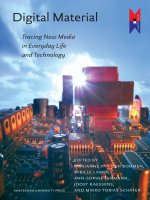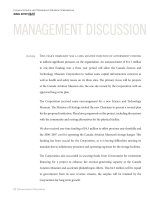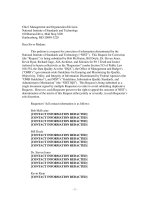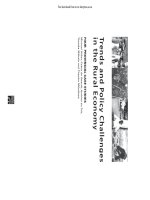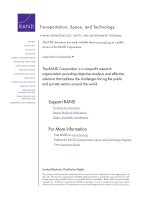Titanium - Industrial Base, Price Trends, and Technology Initiatives ppt
Bạn đang xem bản rút gọn của tài liệu. Xem và tải ngay bản đầy đủ của tài liệu tại đây (666.36 KB, 156 trang )
This document and trademark(s) contained herein are protected by law as indicated
in a notice appearing later in this work. This electronic representation of RAND
intellectual property is provided for non-commercial use only. Unauthorized
posting of RAND PDFs to a non-RAND Web site is prohibited. RAND PDFs are
protected under copyright law. Permission is required from RAND to reproduce,
or reuse in another form, any of our research documents for commercial use. For
information on reprint and linking permissions, please see RAND Permissions.
Limited Electronic Distribution Rights
Visit RAND at www.rand.org
Explore RAND Project AIR FORCE
View document details
For More Information
This PDF document was made available
from www.rand.org as a public service of
the RAND Corporation.
6
Jump down to document
THE ARTS
CHILD POLICY
CIVIL JUSTICE
EDUCATION
ENERGY AND ENVIRONMENT
HEALTH AND HEALTH CARE
INTERNATIONAL AFFAIRS
NATIONAL SECURITY
POPULATION AND AGING
PUBLIC SAFETY
SCIENCE AND TECHNOLOGY
SUBSTANCE ABUSE
TERRORISM AND
HOMELAND SECURITY
TRANSPORTATION AND
INFRASTRUCTURE
WORKFORCE AND WORKPLACE
The RAND Corporation is a nonprofit
research organization providing
objective analysis and effective
solutions that address the challenges
facing the public and private sectors
around the world.
Purchase this document
Browse Books & Publications
Make a charitable contribution
Support RAND
This product is part of the RAND Corporation monograph series.
RAND monographs present major research findings that address the
challenges facing the public and private sectors. All RAND mono-
graphs undergo rigorous peer review to ensure high standards for
research quality and objectivity.
Somi Seong, Obaid Younossi, Benjamin W. Goldsmith
With Thomas Lang, Michael Neumann
Prepared for the United States Air Force
Approved for public release; distribution unlimited
PROJECT AIR FORCE
Titanium
Industrial Base, Price Trends, and
Technology Initiatives
The RAND Corporation is a nonprofit research organization providing
objective analysis and effective solutions that address the challenges facing
the public and private sectors around the world. RAND’s publications do
not necessarily reflect the opinions of its research clients and sponsors.
R
®
is a registered trademark.
© Copyright 2009 RAND Corporation
Permission is given to duplicate this document for personal use only, as long
as it is unaltered and complete. Copies may not be duplicated for commercial
purposes. Unauthorized posting of RAND documents to a non-RAND
Web site is prohibited. RAND documents are protected under copyright law.
For information on reprint and linking permissions, please visit the RAND
permissions page ( />Published 2009 by the RAND Corporation
1776 Main Street, P.O. Box 2138, Santa Monica, CA 90407-2138
1200 South Hayes Street, Arlington, VA 22202-5050
4570 Fifth Avenue, Suite 600, Pittsburgh, PA 15213-2665
RAND URL:
To order RAND documents or to obtain additional information, contact
Distribution Services: Telephone: (310) 451-7002;
Fax: (310) 451-6915; Email:
Library of Congress Cataloging-in-Publication Data is available for this publication.
ISBN: 978-0-8330-4575-1
Cover photo courtesy of AP Photo/The Plain Dealer, C.H. Pete Copeland.
The research described in this report was sponsored by the United States
Air Force under Contract FA7014-06-C-0001. Further information may
be obtained from the Strategic Planning Division, Directorate of Plans,
Hq USAF.
iii
Preface
Titanium is an important raw material that accounts for a significant
portion of the structural weight of many military airframes. It offers an
excellent set of properties, such as high strength-to-weight ratio, high
strength at high temperatures, corrosion resistance, and thermal stabil-
ity, that make it ideal for airframe structures. However, in recent years
a combination of multiple factors caused a major spike in titanium
prices that is expected to significantly influence the acquisition costs of
future military aircraft.
is monograph examines the titanium industrial base, produc-
tion technology, and demand characteristics important to the price of
military aircraft. In particular, it addresses the factors underlying price
fluctuations in the titanium market in an effort to better forecast eco-
nomic risks involved in the market and to improve estimates of the
future cost of military airframes. We attempt to identify what triggered
the unprecedented dramatic increase in titanium metal prices between
2003 and 2006 by presenting an analysis of the raw material markets
themselves. e monograph also reviews new titanium manufactur-
ing techniques and assesses their implications for the production cost
of future military airframes. In addition, it analyzes both supply- and
demand-side determinants of prices and their future prospects.
e research reported here was sponsored by then–Lt Gen Donald
J. Hoffman when he was the Military Deputy, Office of the Assistant
Secretary of the Air Force (Acquisition), SAF/AQ, and Blaise Durante,
SAF/AQX, and was conducted within the Resource Management Pro-
gram of RAND Project AIR FORCE (PAF). e project’s technical
iv Titanium: Industrial Base, Price Trends, and Technology Initiatives
monitor is Jay Jordan, Technical Director of the Air Force Cost Analy-
sis Agency.
is monograph should interest those involved with the acquisi-
tion of systems for the Department of Defense and those involved in
the field of cost estimation, especially for titanium-intensive systems.
is document is one of a series from a PAF project entitled
“Weapon System Costing Umbrella Project.” e purpose of the proj-
ect is to improve the tools used to estimate the costs of future weapon
systems. It focuses on how recent technical, management, and govern-
ment policy changes affect cost. Another PAF report that addresses
military aircraft material cost issues is Military Airframe Costs: e
Effects of Advanced Materials and Manufacturing Processes, MR-
1370-AF, 2001, by Obaid Younossi, Michael Kennedy, and John C.
Graser, which examines cost-estimating methodologies and focuses on
military airframe materials and manufacturing processes. is report
provides cost estimators with factors useful for adjusting and creating
estimates based on parametric cost-estimating methods.
RAND Project AIR FORCE
RAND Project AIR FORCE (PAF), a division of the RAND Corpo-
ration, is the U.S. Air Force’s federally funded research and develop-
ment center for studies and analyses. PAF provides the Air Force with
independent analyses of policy alternatives affecting the development,
employment, combat readiness, and support of current and future aero-
space forces. Research is conducted in four programs: Aerospace Force
Development; Manpower, Personnel, and Training; Resource Manage-
ment; and Strategy and Doctrine.
Additional information about PAF is available on our Web site:
/>v
Contents
Preface iii
Figures
ix
Tables
xi
Summary
xiii
Acknowledgments
xxiii
Abbreviations
xxv
CHAPTER ONE
Introduction 1
Background
1
Study Objective
4
Approach
5
Outline of the Monograph
6
CHAPTER TWO
Titanium Processing 7
Titanium and Its Properties
7
Titanium Metal Products
8
Ores and Concentrates
8
Sponge
8
Ingot
9
Mill Products
9
Production Processes
9
Extracting Titanium Metal from Ore
10
Producing Ingot from Sponge
10
Primary Fabrication: Processing Ingot to Mill Products
13
vi Titanium: Industrial Base, Price Trends, and Technology Initiatives
Secondary Fabrication: Fabrication Parts from Mill Products 14
Scrap
14
Ferrotitanium
15
Production Cost Structure
16
Refining Cost
17
Fabrication Cost
17
Buy-to-Fly Ratio
18
Cost-Saving Technical Changes
18
Summary
19
CHAPTER THREE
e Titanium Industrial Base and Other Market Characteristics 21
Geographic Distribution
21
Major Producers
22
Major Buyers
24
Substitutes and Complements
28
Market Price
29
Oligopolistic Price
29
Market Size and Market Risks
29
Spot Market Versus Long-Term Contracts
30
Import Tariffs
31
Summary
32
CHAPTER FOUR
Supply-Side Drivers of Titanium Price Fluctuations 35
Availability and Price Trends of Raw Material
35
Sponge and Scrap Shortage
36
Depletion of U.S. Titanium Sponge Stockpile
38
Responsiveness of Production Capacity to Demand
39
Excess Production Capacity of Titanium Sponge Until 2004
40
Titanium Sponge Production Capacity Expansion After 2004
41
Other Supply-Side Factors
42
Entry and Exit
42
U.S. Titanium Metal Production Capacity Trends
44
Berry Amendment
45
Contents vii
China’s Impact on Titanium Prices 48
Summary
49
CHAPTER FIVE
Demand-Side Drivers of Titanium Price Fluctuations 51
ree Primary Demand Drivers of the Commercial Aircraft
Manufacturing Industry
52
Commercial Aircraft Orders Skyrocketed
52
Titanium Content per Aircraft Increased
53
Increased Demand from Military Aircraft Manufacturers
53
Increased Demand from the Industrial Sector
55
Increased Spot Market Transactions
57
Interaction of Demand- and Supply-Side Drivers to Bring Out
the Recent Turmoil in the Titanium Market
59
Relationship Between Titanium Price Trends and Demand Shocks
from the Aircraft Manufacturing Industry
59
Titanium Demand from the Commercial Aircraft Industry and
Titanium Price Trends
60
Titanium Mill Product Price Elasticity Before 2004
64
Price Elasticity of Titanium Demand Since 2004
68
Summary
69
CHAPTER SIX
Market Prospects and Emerging Technologies 73
Market Prospects
73
Prospects of the World Titanium Sponge Supply
73
e Impact of China on the Titanium Supply
76
Future Demand for Titanium
77
Summary: Future Titanium Market Balance
81
Developments in Titanium Production Technology
82
Emerging Production Techniques
83
Improved Titanium Extraction and Refinement
84
Titanium Powder Metallurgy
87
Single-Melt Processing
88
Solid Freeform Fabrication
90
Improvements in Machining
91
viii Titanium: Industrial Base, Price Trends, and Technology Initiatives
Cost-Saving Potential of Emerging Technologies 92
Summary: Developments in Titanium Production Technology
93
CHAPTER SEVEN
Conclusions and Policy Implications 95
What Triggered the Recent Titanium Price Surge?
95
China’s Impact on Titanium Prices
97
Market Prospects and Emerging Technologies
97
e Titanium Market in the Near Future
97
Titanium Production Cost Drivers
98
Emerging Technologies
99
Policy Implications
101
Long-Term Contracts Are Needed to Mitigate Market Volatility
102
Monitoring Market Trends to Improve Forecasting Power
103
Reducing BTF Ratio and Optimizing Scrap Recycling
105
Searching for New Technological Opportunities
106
APPENDIXES
A. Aircraft Included in the Titanium Demand Calculation
and Data Sources
109
B. Questionnaire to Industry Experts
111
C. Supply- and Demand-Side Conditions Resulting in the
Recent Titanium Market Turmoil
119
Bibliography
123
ix
Figures
S.1. Producer Price Index Trend for Titanium Mill Products,
1971–2006
xiv
1.1. Percentage of Titanium in the Structural Weight of
Selected Military Aircraft
2
1.2. Producer Price Index Trend for Titanium Mill Products,
1971–2006
4
2.1. Vacuum Arc Remelting Process for Converting Titanium
Sponge into Ingot
11
2.2. Composition of Materials Used to Produce Titanium
Ingot and Mill Products
13
2.3. Converting a Titanium Ingot into an Aircraft Part
15
3.1. Geographic Distribution of World Titanium Sponge
Production Capacity, 2005
22
3.2. U.S. Titanium Sponge Imports by Origin, 2005
23
3.3. Aerospace Industry’s Share of Titanium Sponge
Consumption in the
United States, 1975–2005 26
3.4. Sectors to Which TIMET’s Titanium Mill Products Were
Shipped, 2006
28
4.1. Annual Inflation Rates of Titanium Sponge and Scrap
Prices, 1994–2004
36
4.2. U.S. Titanium Sponge Inventory Stocks, 1990–2006
39
4.3. U.S. Titanium Sponge Import Price, 1985–2004
41
4.4. World Titanium Sponge Production Capacity and
Production Trends, 1995–2006
42
4.5. Titanium Sponge Production Capacity Trends by Country,
1995–2006
43
4.6. U.S. Titanium Sponge Capacity, Consumption, and
Imports, 1994–2005
45
x Titanium: Industrial Base, Price Trends, and Technology Initiatives
4.7. U.S. Titanium Ingot Capacity and Capacity
Utilization Rate, 1994–2005
46
5.1. Commercial Aircraft Orders and Deliveries, 1974–2006
52
5.2. Average Titanium Buy Weight per Commercial Aircraft,
1984–2006
54
5.3. Military Aircraft Titanium Buy Weight Based on
Delivery Year, 2000–2006
55
5.4. Titanium Demand from Military and Commercial
Aircraft Deliveries, 1991–2006
56
5.5. Global Titanium Demand by Sector, 1997–2006
57
5.6. PPI Fluctuations for Titanium Mill Shapes and Supply
and Demand Shocks in the Industry
63
5.7. Titanium Demand from Commercial Aircraft Deliveries
and Titanium Mill Shapes PPI Trend, 1985–2005
64
5.8. Trends of U.S. Titanium Shipments, Demand from
Commercial Aircraft Deliveries, and PPI, 1996–2005
65
5.9. Titanium Mill Product Shipment Trend in the United
States Compared with at in the Rest of the World
66
5.10. Comparison Between the PPI for Titanium Mill Shapes
and TIMET’s Average Mill Product Price, 1996–2004
68
5.11. PPI Trends for Various Metals, 1986–2006
70
6.1. Planned Expansion of World Titanium Sponge Capacity
rough 2010
75
6.2. Forecasted Commercial Aircraft Deliveries and Future
Titanium Demand
78
6.3. Emerging Technologies of Titanium Production
84
xi
Tables
1.1. Price Determinants of Titanium 5
2.1. Cost Comparison of the Stages of Metal Production
16
3.1. World Titanium Mill Product Shipments by End-User
Sector, 2005–2006
27
5.1. Significant Events Affecting the Titanium Market,
1971 –2005
61
6.1. Future Scenarios of World Titanium Demand in 2010
80
6.2. Potential of Emerging Cost-Saving Technologies
93
A.1. Aircraft Included in the Titanium Demand Calculation
and Data Sources
109
B.1. Emerging Technologies and eir Cost-Saving Potentials
118
C.1. Titanium Supply- and Demand-Side Events, Early
1990s–2006
119
xiii
Summary
Titanium is an important raw material accounting for a significant
portion of the structural weight of most military airframes. It offers an
excellent set of properties, such as high strength-to-weight ratio, high
strength at high temperatures, corrosion resistance, and thermal stabil-
ity, that make it ideal for airframe structures. However, in recent years
a combination of factors caused a major spike in titanium prices that is
expected to influence the acquisition costs of future military aircraft.
Between 2003 and 2006, the price of this expensive metal
increased at an unprecedented rate, more than doubling during this
period. Government and industry observers said this was the first time
a global materials supply concern has affected the defense sector since
the steel shortage after World War II (Murphy, 2006). ey also noted
that the short supply of titanium might influence delivery schedules for
military aircraft and weapons (Toensmeier, 2006). ere are worries
that titanium shortages may substantially raise the program cost of the
F-35 (Murphy, 2006; Defense Industry Daily, 2006). Although prices of
titanium products have fluctuated over the years, the recent price surge
was extreme compared to previous fluctuations (see Figure S.1).
Study Objective and Approach
e Office of the Assistant Secretary of the Air Force for Acquisition
asked PAF to conduct this study in order to better understand the fac-
tors underlying price fluctuations in the titanium metals market, to
better forecast economic risks involved in the market, and to improve
xiv Titanium: Industrial Base, Price Trends, and Technology Initiatives
estimates of the f uture cost of milita ry airfra mes. To do so, we attempted
to answer three primary questions:
What triggered the recent titanium price surge? t
What are the future market prospects and emerging t
technologies?
What are the policy implications for U.S. military buyers of t
airframe structures and other titanium-intensive weapons?
Although a previous RAND study (Younossi, Kennedy, and
Graser, 2001) focused on the costs of processing raw materials into air-
frame parts, this study analyzes the actual raw material markets. It also
reviews new manufacturing techniques and assesses their implications
for the production cost of future military airframes.
Based on literature reviews and analyses of historical data avail-
able in defense and commercial industries, this monograph assesses the
past trends, current changes, and future prospects for each of the tita-
nium price determinants and their relative importance. In particular,
Figure S.1
Producer Price Index Trend for Titanium Mill Products, 1971–2006
Titanium mill product Producer Price Index
(1982 = 100)
200
50
200119911981 1996198619761971
350
0
150
100
250
300
SOURCE: Producer Price Index data from the Bureau of Labor Statistics.
RAND MG789-S.1
2006
Summary xv
the study analyzes both supply- and demand-side price determinants
and their future prospects.
To widen our understanding of the titanium industry, we con-
ducted interviews with experts from the titanium manufacturing and
processing industries, the aircraft manufacturing industry, and govern-
ment agencies compiling titanium price data, such as the United States
Geological Survey and the Bureau of Labor Statistics.
1
(See pp. 1–6.)
Titanium Is Expensive to Produce
Titanium is expensive to refine, process, and fabricate. In terms of pro-
cessing cost per cubic inch, titanium is five times more expensive than
aluminum to refine and more than ten times as expensive as aluminum
to form into ingots and to fabricate into finished products. Titanium
sponge is the commercially pure form of titanium metal that is refined
from titanium ore.
2
Titanium ingot is produced from titanium sponge,
titanium scrap, or a combination of both.
3
Titanium mill products,
such as plate, sheet, billet, and bar, are produced from titanium ingot
through such primary fabrication processes as rolling and forging.
Titanium parts are then produced from mill products by means of sec-
ondary fabrication processes, such as forging, extrusion, hot and cold
forming, machining, and casting. Fabrication is the most costly pro-
cessing stage, followed by sponge production. (See pp. 7–20.)
What Triggered the Recent Titanium Price Surge?
It is a common belief that cyclical fluctuations of titanium prices are
mainly driven by demand-side events, especially aircraft demand cycles.
However, the Producer Price Index (PPI) for titanium mill shapes in the
United States was relatively insensitive to the declining demand from
1
Appendix B contains questions asked of industry experts.
2
It is called sponge because of its porous, sponge-like appearance.
3
Titanium scrap is a by-product of the fabrication processes.
xvi Titanium: Industrial Base, Price Trends, and Technology Initiatives
the commercial aircraft industry during the previous downturn (1998–
2003), contrary to common belief. is is because world titanium
demand did not decrease as severely as commercial aerospace demand.
In the global titanium market, industrial demand, historically more
stable than aerospace demand, had dominated aerospace demand since
the mid 1990s. e industrial titanium market bottomed out in 2001,
earlier than the aerospace market, which hit bottom in 2003. Driven
by the growth in industrial demand, global titanium demand was
already at its previous peak level in 2004. is contributed to amplify-
ing the impact on titanium price and supply availability of the historic
aircraft order surge in 2005 and 2006. Given that industrial demand
dominates the global market, commercial aerospace demand is not the
only major driver of titanium market prices. In fact, the extreme price
volatility in the recent titanium market resulted from the coincidence
of various supply-side and demand-side price drivers.
Supply-Side Drivers
On the supply side, prices of titanium sponge and scrap began increas-
ing sharply even before the significant surge in commercial aircraft
orders in 2005 and 2006. ere was an extreme shortage of titanium
scrap in 2003, because of the low aircraft production rate, which
resulted in less recycled scrap. is coincided with the period during
which China’s dramatic growth in steel consumption
4
drove up the
prices of ferrotitanium,
5
an alloy used in the steel production process.
e ferrotitanium price surge led to increased demand for titanium
scrap and sponge, both of which are close substitutes for ferrotitanium
in steel production. e cross-market substitution effect was signifi-
cant, because the steel market size was 10,000 times that of titanium.
In addition, the Defense Logistics Agency titanium sponge stockpile
depletion in 2005 also coincided with the sponge and scrap market
shortage, worsening the titanium raw material supply shortage. e
4
World steel prices increased dramatically in 2003–2004, driven mainly by China’s strong
demand and world economic recovery.
5
Ferrotitanium is used in steel production processes for deoxidation, achieving a finer
grain structure, and controlling carbon and nitrogen.
Summary xvii
stockpile depletion, which had been authorized by Congress, started in
1997; by 2005, there was no titanium sponge left in the stockpile. Since
the supply of titanium raw materials was already tight in 2003–2005,
the additional demand shock from the record-high level of commercial
aircraft orders in 2005 and 2006 intensified the shortage. In addition,
titanium metal suppliers were not able to respond quickly to ameliorate
the supply shortage. In particular, expanded sponge capacity required
building an additional factory, which would take about three years
and an investment of $300 million to $400 million. Right before the
recent demand surge, titanium producers had suffered from several
lean years, and some producers were on the verge of bankruptcy. As
a result, the producers hesitated to invest in capacity expansion until
they were assured that increased demand would continue for at least
the next several years. (See pp. 35–50.)
Demand-Side Drivers
On the demand side, there have been three main demand drivers in
the aircraft manufacturing industry in recent years. First, commercial
aircraft orders skyrocketed as both Boeing and Airbus received record
levels of orders during 2005 and 2006.
6
Second, the average level of tita-
nium content per aircraft rose significantly, which meant that increases
in aircraft orders in turn amplified the demand for titanium. ird, the
demand for titanium in military aircraft production also increased sig-
nificantly, as full-time production of the F-22A Raptor began in 2003.
7
ese three demands coincided to create a record-breaking increase in
titanium demand.
In addition, increases in military armor and industrial demand
for titanium added to the demand surge from the aircraft industry.
Even before the surge in aircraft demand, the global titanium market
6
We obtained commercial aircraft order and delivery data from the Boeing and Airbus
Web sites.
7
Full production of the F-22 was funded in fiscal year (FY) 2003. Refer to the Defense
Acquisition Management Information Retrieval Web site, Selected Acquisition Report for
the F-22A, December 31, 2006.
xviii Titanium: Industrial Base, Price Trends, and Technology Initiatives
was already tight because of high demand from the industrial equip-
ment industry, the steel industry, and other titanium users.
Titanium price volatility was further exacerbated by an increase
in spot transactions on the titanium market in 2005 and 2006. During
this period of demand surge, even aircraft manufacturers, which nor-
mally rely on long-term contracts for their titanium, had to procure
titanium on the spot market because of the supply shortage and long
lead times.
8
In such a strong seller’s market, titanium prices were sub-
ject to the titanium producer’s bargaining power.
On the whole, increased demand for titanium exceeded the avail-
able supply of scrap and sponge, as well as the production capacity for
new titanium metal. Given the fact that titanium sponge production
capacity expansion requires a high capital investment and long lead
times, sponge supply expansion was simply not responsive enough to
meet the unexpected surge in demand over the short run. Moreover,
given the long record of excess capacity in the industry, titanium pro-
ducers were reluctant to invest in capacity expansion until they were
assured that the strong demand was not temporary. e market imbal-
ance was further worsened by the spurt of speculative purchasing on
the spot market, which amplified price volatility. Titanium prices sky-
rocketed and remained extremely volatile from 2003 to 2006. (See pp.
51–71.)
Market Prospects and Emerging Technologies
Titanium Markets in the Near Future
By the end of this decade, the world titanium sponge production capac-
ity is expected to almost double its 2005 capacity, growing to approxi-
mately 217,970 tons per year. In response to the recent demand surge,
many titanium metal producers have announced increases in titanium
sponge capacity or have taken steps to increase in the near future. If
8
Some of the military aircraft contractors had minimal protection of long-term contracts
and were exposed to the risk of price volatility and supply shortage to a greater extent, as they
had to purchase titanium for one lot production at a time.
Summary xix
new titanium sponge plants become fully operational as planned, Japan
and China will be the top titanium sponge producers in the world, fol-
lowed by Russia and the United States.
For market prospects, we examined three potential scenarios of
world titanium demand: optimistic, base, and pessimistic. In each sce-
nario, we assumed a certain combination of annual average growth
rates in titanium demand from the aerospace and industrial market
segments and then calculated the projected demand in 2010 in relation
to the actual 2005 demand.
We do not attach probabilities to each of the potential future sce-
narios; rather, we use the scenarios to bound predictions for the future.
As a result, different combinations of demand and supply scenarios will
result either in a variety of potential market imbalances or in market
equilibrium.
Assumptions regarding the following three factors heavily influ-
ence the future titanium market outlook:
realization of the capacity expansion plans by titanium suppli-1.
ers, including American and Chinese producers
the Boeing 787 build rate and demand from other titanium-2.
intensive aircraft
continued Chinese economic growth and Chinese consumption 3.
of steel, titanium, and other metals that are related to world tita-
nium demand and supply conditions.
By comparing the demand scenarios and production capacity
expansion plans, we determined that the titanium industry’s current
capacity expansion plans appear to be based on the future demand
expectations inherent in the optimistic scenario. erefore, if the base
demand scenario is realized (instead of the optimistic scenario) and
the world titanium production capacity expands as planned, we expect
there will be excess production capacity in the titanium market by
2010. (See pp. 73–82.)
xx Titanium: Industrial Base, Price Trends, and Technology Initiatives
Emerging Technologies
Breakthroughs.
Of the experts we interviewed, only a few were
optimistic about any dramatic changes in titanium metal extraction,
processing, and production technologies that may be realized within
the next ten years. In addition, the titanium industry has not identi-
fied any particular technology that is worthy of an aggressive invest-
ment for a medium-term (three- to five-year) return. Titanium compa-
nies are taking a “wait and see” position on significant technological
breakthroughs.
Technologies with Cost-Saving Potential. After reviewing the lit-
erature and conducting discussions with industry experts, we devel-
oped a list of emerging technologies with at least marginal cost-saving
potential. ese technologies are classified into five categories:
improved extraction and refinement t
powder metallurgyt
single-melt refiningt
solid freeform fabricationt
improved machining.t
We then assessed these technologies based on their time frame,
feasibility of application to the market, and potential for cost savings.
e greatest potential cost savings lie in the combination of
improved extraction processes and powder metallurgy, a specialized
titanium production process that would limit waste and remove many
steps from the current production process. If successful, the higher
yield and increased speed of this process would expand the amount of
titanium on the market and considerably shorten lead times, dramati-
cally changing the titanium industry over the next decade. However,
this combination of developments is unlikely to occur in the near or
mid term and is still technically uncertain.
Single-melt refining (instead of multiple-melt refining) and
improved machining also would improve production yields and save
time and energy. Although the savings from these improvements are
expected to be smaller than the savings offered by improved extraction
Summary xxi
and powder metallurgy, they are also expected to be much steadier and
more consistent.
Across these new technologies, most savings will be realized by
improved yields resulting from reduced waste during processing and
part fabrication. Improved labor efficiency will yield some savings,
especially during the fabrication process. Energy savings should be an
important, but much smaller, proportion of the savings, primarily con-
centrated in improvements during initial extraction and melting.
e emerging technologies have the potential to reduce costs suf-
ficiently to open new markets, such as military ground vehicles. How-
ever, it will take a long time for these technologies to influence the cost
of aerospace-grade titanium substantially.
Barriers to Adopting New Technologies. A major barrier to adop-
tion of new technologies in aerospace applications is the required cer-
tification of new materials. Aerospace manufacturing standards are
typically based either on judgments by a government body, such as the
Federal Aviation Administration or the U.S. Air Force, or on standards
set by the primary aircraft manufacturers. Within the Air Force, mate-
rials and processes must be certified separately for each program. e
certification process typically lasts 18 to 24 months and requires exten-
sive qualification processes. In the course of this process, a company
must manufacture test articles and validate their properties at its own
expense. e cost of this process prevents companies from attempting
to certify materials until they are quite certain of their performance
and properties. Consequently, an innovative titanium product or pro-
cess must be used for several years in other applications before design-
ers will consider it for aerospace uses. (See pp. 82–94.)
Policy Implications
Based on the findings of this study, we suggest policy measures in five
areas: improving contract practices, monitoring market trends, reduc-
ing buy-to-fly ratios, optimizing scrap recycling, and exploring new
technological opportunities. (See pp. 95–107.)
xxiii
Acknowledgements
We thank the sponsors of this project, then–Lt Gen Donald J. Hoff-
man, former SAF/AQ, and Blaise Durante, SAF/AQX. We are grateful
to Mr. Durante for his long-term support of PAF’s cost analysis and
acquisition research. We extend our appreciation to Maj Gen Jeffrey
Riemer, former F-22A Program Executive Officer, for allowing us to
accompany him on his many contractor visits. We also thank the proj-
ect monitors, Richard Hartley, Deputy Assistant Secretary for Cost
and Economics, Office of the Assistant Secretary of the Air Force for
Financial Management and Comptroller, and Jay Jordan, Technical
Director for the Deputy Assistant Secretary for Cost and Economics.
We are grateful to Edward Rosenberg of the F-22A Program Executive
Office for helping us establish contacts with many titanium vendors
and experts.
is study benefited greatly from discussions with experts from
the titanium manufacturing and processing industries and the aircraft
manufacturing industry, as well as government agencies that com-
pile titanium price data. e authors are thankful for their valuable
insights.
We would like to acknowledge the following principal points of
contact at each organization we visited or interviewed with. At gov-
ernment organizations, we thank Jane Adams, Army Research Labo-
ratory; Joseph Kowal, Bureau of Labor Statistics; Leo Christodolou,
Defense Advanced Research Projects Agency; and Joseph Gambogi,
United States Geological Survey.
Among industry organizations, we thank omas Bayha, Allvac
Incorporated; omas Blanchard, Christopher DeForest, Jeffrey K.


